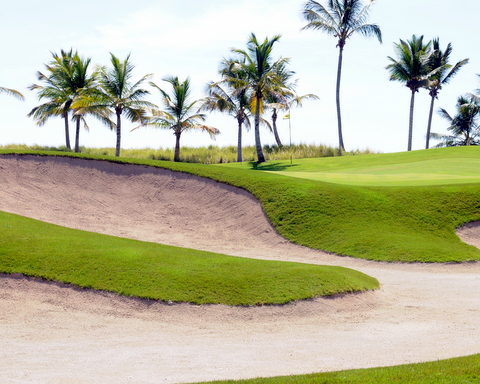On the eastern edges of the island of Hispaniola, in the Dominican Republic, the land is formed from coral. The Caribbean Sea has frothed and foamed against it for centuries, gradually forming sharp cliffs. As Jack Neville and Alister MacKenzie demonstrated on California’s Monterey Peninsula during the last century (at Pebble Beach and Cypress Point), this sort of meeting of earth and water can be an auspicious place for golf.
At Corales, which opened in 2010 at the Punta Cana Resort and Club, Tom Fazio got his chance to test himself against the standard set by Neville and MacKenzie. He did not quite match their achievement. But Corales is still a splendid golf course, one of the best in the Caribbean and one of the best winter resort courses in the world.
Corales has four holes which run along the cliffs, with the blue Caribbean forming a spectacular lateral hazard. Two others play from inland tees to greens set atop the cliffs. Inland, Fazio sculpted ponds and hills from the original flat terrain, so deftly that it almost looks as if God gave him hilly ground to work with. He made two holes, Nos. 3 and 15, with alternate greens, like the 8th at Pine Valley. Many of the greens are set on plateaus and hilltops and guarded by deep front bunkers.
But it’s the seaside holes by which the course will be known and assessed. The first of them, No. 8, is a par four, 399 yards from the back tees. The tee shot, helped by the prevailing breeze, has to carry a patch of rough coral that stretches anywhere from 232 to 86 yards, depending on which of five tees the player has chosen. Like most fairways at Corales, the short grass on No. 8 is generous, but there are bunkers and waste areas waiting to ensnare a player who timorously pushes a ball away from the cliff. The pitch to a small green has to carry a cleft in the cliff to reach the green. The green on the 9th, a par three that plays from 204 to 115 yards, must carry another cleft into which the sea pours, sending up periodic plumes of white spray.
Coming home, the player returns to the sea via the 16th hole, a long par four that plays directly into the wind. The 17th is a par three, 210 to 105 yards, laid out atop the cliff, with the sea on the right. When the breeze is up, a player must either hit a fade that holds its line against the prevailing wind or aim out over the cliff and trust that the wind won’t stop blowing.
No. 18, the course’s signature hole, plays around or over a cove, reminiscent of Stillwater Cove at Pebble Beach. From the back tees, at 501 yards, the tee shot requires an enormous carry, 288 yards, against the prevailing wind.
On the day I played, there were no markers on the back tees, and I suspect they aren’t used very often. The route from the middle tee (406 yards) was far less dramatic. All of the tee shot was over land, and so was the second shot. Fazio evidently chose not to try to build a hole like No. 8 at Pebble, where every second shot has to make the heroic–and memorable–carry over a piece of the cove to reach the green.
The developers of the course have set a plaque near the 16th tee, advising players that the closing stretch is known as “El Codo del Diablo,” (The Devil’s Elbow) and that “these final three holes have been masterfully and strategically designed to assess the golfer’s mettle and boldly challenge all levels of play.”
No doubt that’s an homage of sorts to named stretches of holes like Amen Corner at Augusta National. It would feel more appropriate, though, if the name had come from a sports writer or a golfer. On a new golf course with lots of home sites waiting for buyers, “El Codo del Diablo” feels like a marketing gimmick.
And Corales doesn’t really need gimmicks. While it doesn’t quite match Pebble or Cypress Point, it still is a beautifully conditioned, very challenging course with a magnificent setting.
Corales, I was told, may someday operate as a private club. At the moment, though, it’s open to play by guests of the Punta Cana resort.



